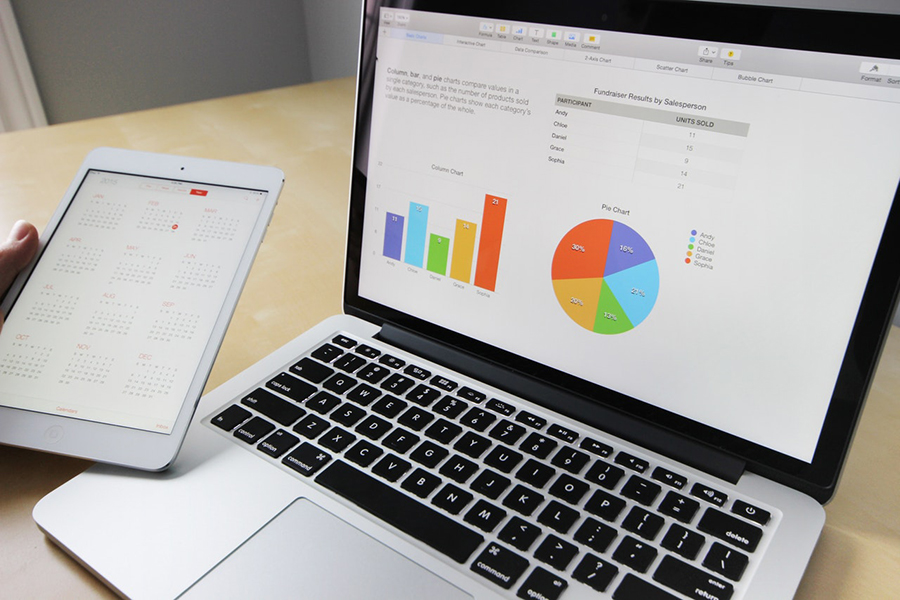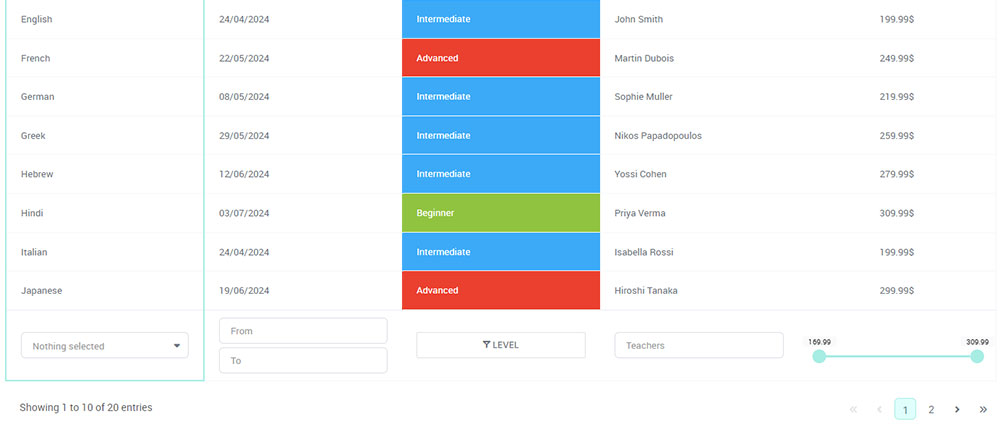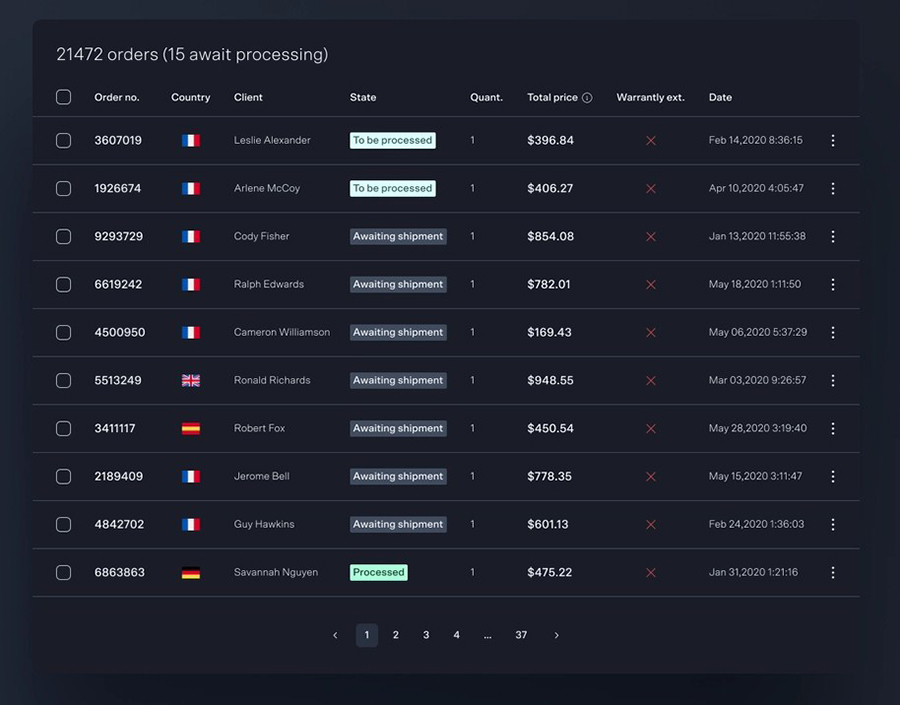Data visualization is the pulse of modern digital communication, transforming raw numbers into compelling stories through dynamic charts and interactive graphs.
As a professional, I’ve seen the magic unfold with Chart.js, a powerful JavaScript library that puts data representation right into your hands.
Whether it’s bar charts, pie charts, or inventive doughnut charts, Chart.js thrives on providing developers with the tools to create visually stunning charts using the Canvas API.
Imagine pristine chart legends and seamless integration into your workflow—traits every web developer desires. Today, with the rising demand for clarity in data visualization, embracing Chart.js could be the game-changer your projects need.
By the end of this article, you’ll delve into the realms of chart customization, harness the potential of responsive charts, and unravel various chart options and configurations.
Embark on this exploration of a tool that seamlessly merges aesthetics with utility, breathing life into your data through mesmerizing visuals.
Table of Contents
Getting Started with Chart.js
Installation and Setup
Installing Chart.js via CDN
To install Chart.js via a CDN, you can follow these steps:
1. Include the Chart.js CDN in Your HTML: You need to add a <script> tag in the <head> or just before the closing </body> tag of your HTML document. Here are two popular CDN options:
- Using jsDelivr:
<script src="https://cdn.jsdelivr.net/npm/chart.js"></script>
- Using CDNJS:
<script src="https://cdnjs.cloudflare.com/ajax/libs/Chart.js/4.2.0/chart.umd.js"></script>
2. Create a Canvas Element: You need a <canvas> element in your HTML where the chart will be rendered. For example:
<div> <canvas id="myChart"></canvas> </div>
3. Instantiate the Chart: After including the Chart.js script, you can create a chart by adding a JavaScript block. Here’s an example of how to create a simple bar chart:
<script>
const ctx = document.getElementById('myChart').getContext('2d');
const myChart = new Chart(ctx, {
type: 'bar',
data: {
labels: ['Red', 'Blue', 'Yellow', 'Green', 'Purple', 'Orange'],
datasets: [{
label: '# of Votes',
data: [12, 19, 3, 5, 2, 3],
borderWidth: 1
}]},
options: {
scales: {
y: {
beginAtZero: true
}}}});
</script>
Installing via NPM/Yarn
To install Chart.js using NPM or Yarn, you can follow these straightforward steps:
Using NPM
- Navigate to your project folder:
cd my_project
- Initialize a new Node.js project (if you haven’t already):
npm init -y
- Install Chart.js:
npm install chart.js
Using Yarn
- Navigate to your project folder:
cd my_project
- Initialize a new Node.js project (if you haven’t already):
yarn init -y
Install Chart.js:
yarn add chart.js
Example Usage
After installation, you can include Chart.js in your HTML file. Here’s a simple example to create a bar chart:
<!DOCTYPE html>
<html lang="en">
<head>
<meta charset="UTF-8">
<meta name="viewport" content="width=device-width, initial-scale=1.0">
<title>Chart.js Example</title>
</head>
<body>
<canvas id="myChart"></canvas>
<script type="module">
import { Chart, registerables } from 'chart.js';
Chart.register(...registerables);
const ctx = document.getElementById('myChart').getContext('2d');
const myChart = new Chart(ctx, {
type: 'bar',
data: {
labels: ['A', 'B', 'C'],
datasets: [{
label: 'Test Dataset',
data: [10, 20, 15],
backgroundColor: ['red', 'green', 'blue'],
}]
},
});
</script>
</body>
</html>
Important Notes
- Chart.js is an ECMAScript module, so ensure to use the
type="module"attribute in your script tag when importing it directly in the browser. - If you are using a bundler like Parcel, Webpack, or Vite, you can follow the respective setup instructions for those tools to manage your dependencies more effectively
Setting Up Chart.js in a Project
As you marry this tool with your digital canvas, a few strokes are left to polish.
After installation, configuring paths, linking scripts, and initializing your first line of code are your markers.
It’s akin to setting a table before a grand feast—except the feast, in this case, feeds on pixels and data.
Basic Configuration
Understanding the Core Structure
Peeling back the layers reveals the core of Chart.js. An essence, if you will, where the bones of your chart lie.
It’s a blend of datasets, labels, options—a recipe where every ingredient strikes a balance, ensuring your visuals not only inform but delight.
Creating Your First Chart
A blank canvas welcomes your imaginative touch. Bar, line, pie—the choices are vast.
Declare, initialize, and render. And as the colors fill in, the patterns emerge, you’re not just arranging data—you’re orchestrating an experience.
Basic Options and Settings
Let’s talk options, the master strokes that finesse your chart’s appeal. Colors that pop, legends that guide, tooltips that enlighten.
Yet, the potential runs deeper—a flip here, a toggle there, and suddenly your chart tells its own story. Simple sliders tweak the story’s tone, culminating in an interactive tapestry that bows only to your vision.
Your beautiful data deserves to be online
wpDataTables can make it that way. There’s a good reason why it’s the #1 WordPress plugin for creating responsive tables and charts.

And it’s really easy to do something like this:
- You provide the table data
- Configure and customize it
- Publish it in a post or page
But it’s not just about looks—it’s highly functional too. Whether you need to create large tables with up to millions of rows, utilize advanced filters and search, or even make your tables editable, wpDataTables has you covered.
And for those who love working with data visualization, wpDataTables supports the powerful Chart.js library. You don’t need to know a single line of code to add Chart.js to your website. Just use the intuitive wpDataTables interface to create and customize your charts.
Chart Types and Their Usage
Data speaks volumes, and the way it’s visualized can amplify that voice or whisper it away. Here, the palette of Chart.js flexes its muscles, offering a diverse array of visual narrators for every tale woven from numbers.
Basic Chart Types
Line Charts
Chart created with wpDataTables
Picture a skyline at twilight, only this skyline trails off into a graph, charting trends.
Line charts paint tales of data progression with a simplicity that strikes—it’s a dance of points connected across your display, sketching arcs and slopes with a dash of elegance.
Bar Charts
Chart created with wpDataTables
Solid and strong, bar charts are the stalwart custodians of comparison.
They plant their feet firmly on scales of time or quantity, standing tall or wide, offering clarity in juxtaposition. Imagine columns of a great hall, each marking its measurement across the temporal or categorical divide.
Pie and Doughnut Charts
Chart created with wpDataTables
Round and inviting, these charts slice through complexity with a single rotation.
Pie charts serve insights on a circular platter, while doughnuts add a touch of flair with minimalist centers, making room for your own touch of design within their embrace.
When I crave proportion showcased in a familiar form, they answer.
Radar Charts
In a realm where axes abound, radar charts weave strands into a web, capturing performances across metrics.
Each spoke plots a distinction, every line encircles an entity, painting radial portraits that defy the mundane.
Advanced Chart Types
Polar Area Charts
Chart created with wpDataTables
Step into the circle’s embrace as polar area charts spread segments around a focal point, showcasing relative size within angle slices.
Imagine petals of a numeric daisy, each petal asserting its significance in a harmonious rotation.
Bubble Charts
Expect the unexpected when datasets collide into dimensions. Bubble charts float through this expanse, their size a testament to value.
Within these playful orbs, stories of correlation frolic, as visuals expand from mere flatness into a 3D charade of information.
Scatter Charts
When individual points hold the keys to the kingdom, scatter charts scatter insights across the coordinates, like stars in a mathematical night sky.
Each dot marks the confluence of two variables—a subtle introduction within their plotted existence.
Check out Chart.js examples
Mixed and Multi-Axis Charts
Combining Different Chart Types
Fusion in its most captivating form—combine for contrast and clarity.
Imagine bars nestled among lines, or dots frolicking alongside areas, each variant sings a chorus of insight. As the audience, each chart offers its unique interpretation.
Configuring Multi-Axis Charts
Scaling these heights involves marrying distinct verticals, aligning them seamlessly.
Multi-axis configurations whisper subtle complexities, merging disparate measures into harmonious duality.
Here lies both opportunity and pitfall; the balance sought is both a boon and a bane if care wavers.
Customizing Charts in Chart.js
The beauty of data is like clay—malleable, receptive; it waits for an artisan’s touch.
With Chart.js, bring out the chisels and brushes, for a transformation awaits.
Appearance Customization
Changing Colors and Themes
Colors: the spark of life in the world of visuals. Channel your inner palette whisperer to breathe vibrancy into your charts.
Adapt themes to echo your brand’s aura or to set a digital mood—rich blues, vivid reds, calm pastels—the canvas complies with a mere stroke of code.
Customizing Fonts and Labels
Words matter. So do their style. Fonts tell tales of their own, whether they sing in serif or dance in sans-serif.
Labels, the silent narrators, need configuring to relay stories aptly—size, weight, alignment—pick and play, with each choice weaving a narrative thread.
Adjusting Chart Dimensions and Layout
Space. The final frontier where charts stretch, shrink, or spread. These dimensions are not constraints but opportunities.
Adjust, align, arrange—the power to mold the layout rests in your hands.
Data Customization
Dynamic Data Binding
To visualize is human, but to bind dynamically, divine.
Real-time reflection of changing data pulses through your charts like electricity through lines, offering immediacy, relevancy, alive with each refresh.
Handling Large Datasets
Waterfalls of data cascading down, magnificent yet daunting.
Finesse required here, navigating vast vistas of variables—streamline, segment, optimize so that not one byte is left behind.
Data Transformation and Preprocessing
Before the visual feast comes preparation. Shape the raw, unsullied data—reshape, refine, ready it for display.
Here lies the alchemy of transformation, creating clarity from chaos before splattering insights onto your digital fresco.
Interaction and Animation
Adding Tooltips and Hover Effects
Interactions enhance a dance—a flirtation with insights. Tooltips flirt with the cursor, offering whispers of data as one hovers; their fleeting hints unravel stories hidden within numbers.
Configuring Animations and Transitions
Momentary blurbs—data in motion. Tune animations to captivate, transitions to guide the eye smoothly across landscapes of data, a symphony harmonious yet subtle.
Implementing User Interaction Features
Click, drag, drop—the clicks of engagement ringing loud. Interaction births a narrative unique for each user, drawing them deeper into the data’s embrace where texts and metrics intertwine, constructing a personalized fable rich in knowledge and allure.
Working with Plugins in Chart.js
Plugins—a mysterious realm where functionality bends to the will of the creator.
In the world of Chart.js, they are the architects of enhancement, crafting extensions that elevate from mere charting to something extraordinary.
Introduction to Chart.js Plugins
What Are Plugins?
In the simplest terms, plugins are whispered secrets, small pieces of code that enhance power without claiming fame.
They extend, expand, embellish—transforming the mundane into the magnificent. Imagine turning dull stats into a picturesque narrative, with the brushstroke of a plugin.
Benefits of Using Plugins
Why stop at basics? Plugins grant freedom. They cater to desires unspoken, unlocking capabilities that elevate charts from simple data points to vibrant compositions.
Annotations, zoom capabilities, labels—each plugin unfurls a new dimension of control and creativity.
Popular Chart.js Plugins
Chartjs-plugin-annotation
Mark the important, highlight the pertinent—this plugin is your ally in drawing attention.
Annotate charts with lines, boxes, and points that declare, “Look here!” without words, just lines of code. An artistry that leads the viewer’s eye with precision.
Chartjs-plugin-zoom
Control is bliss, and zoom is its scepter. Traverse the span of your data with ease, dive into details like a hawk seeking prey.
This plugin grants users the autonomy to explore, to zoom in, to pan—a panoramic adventure at their fingertips.
Chartjs-plugin-datalabels
Numbers alone, though powerful, can be silent whispers. With this plugin, every point in your chart speaks—clear, concise, essential.
Enhance your charts with labels that accompany data with clarity, ensuring insights never slink away unnoticed.
Creating Custom Plugins
Understanding the Plugin API
The canvas is vast, and the API is your guide. Here lies the map, the blueprint, to bend the existing into something new.
It’s where knowledge and creativity converge, morphing the standard into the exceptional.
Developing a Simple Plugin
Start small. An idea takes form—parameters are set, functions declared, and soon, your creation breathes.
Like sculpting clay, you mold, tweak, refine—a simple idea becomes an agile accomplice in the dance of data.
Best Practices for Plugin Development
The essence of crafting a plugin echoes through practice. Prioritize efficiency, ensure compatibility, and let the code flow naturally—like a stream finding its path through rocks.
Transparency and documentation shield against the pitfalls that shadow development’s path.
Chart.js Integration with Frameworks
Embarking on the journey where graphical grace meets structural robustness is thrilling.
The harmony of Chart.js with modern frameworks is like a dance of elegance and power, weaving tales of data across the vast realm of the web.
Integrating with Front-End Frameworks
Using Chart.js with React
React—where components live and breathe dynamically—a playground for seamless UI.
Chart.js merges in harmoniously, like an artist joining an orchestra. With hooks and states, charts flicker alive within components, shifting with each prop and rendering new stories.
Integrating with Vue.js
Vue.js, the elegant fabric of reactivity. Here, with directives and data binding, charts manifest smoothly in data-driven views.
It’s like sculpting a digital illusion, fashioned with care and precision, where interactivity leaps from code to canvas.
Working with Angular
The braid of structure and modularity. Enter Angular—where dependency injection and TypeScript reign supreme.
In this domain, Chart.js enlists the might of components and services, creating symphonies of visualization embedded in directives and modules.
Backend Data Integration
Fetching Data from APIs
Data—the lifeblood that pumps through digital veins. APIs act as conduits, feeding charts the nectar of information.
JSON responses flow, parsed and processed, laid out as canvas masterpieces. Every call a brushstroke, painting a portrait of real-time reality.
Real-Time Data with WebSockets
Electricity, quicksilver, data flows swift and unbound. WebSockets inject immediacy, links to streams that pulse with life.
As events cascade, charts dance—a choreography of bits and bytes that narrate tales of the present moment, raw and unfiltered.
Integration with Server-Side Languages (Node.js, PHP)
Behind the curtain, backstage wizards craft the backend magic. With Node.js, async spells weave responsive interactions, an echo chamber of APIs and sockets.
PHP, a steadfast sentinel, delivers structured reservoirs of data, ready to be translated into vivid visuals.
Together they create a bridge from back to front, where data becomes an argument, a conversation, alive on the screen.
Performance Optimization in Chart.js
The quest for speed, efficiency, and whisper-light performance is one all digital artisans must embark upon.
Chart.js offers a tapestry of elegance, but weaving it to perfection requires skillful hands and a thoughtful mind.
Optimizing Rendering Performance
Techniques for Reducing Load Time
Milliseconds matter. A canvas delayed is a user betrayed.
To streamline render, embrace lazy loading like an old friend—prioritize what you show, hide the rest till needed. Minification is magic, shrinking scripts to slipstream efficiency.
Efficient Data Handling
Data is a fickle beast, wild and untamed. Tackle it with precision—the masterful art of consolidation and filtering.
Fewer points, bigger insights—it’s not the size, but how you wield that makes the difference. Aggregation—it slices through chaos, bringing harmony to the numbers.
Leveraging Asynchronous Data Loading
Attach the strings of async cunning. Fetching, processing, all in the dance of asynchronous delight.
Let the page breathe, let it flow—the data arrives at its leisure, but the performance remains snappy, agile, ever-responsive.
Memory Management
Understanding Memory Consumption in Chart.js
Memory—both a friend and a fiend. Understanding its consumption is the first step—know its pathways and abide.
Acknowledge the stages, the allocations, embrace the knowledge to rule over memory’s kingdom wisely.
Best Practices for Memory Optimization
Tread carefully, gently—dispose what you no longer require.
Employ garbage collection as a guardian, a silent steward watching over, ensuring wastage is minimized. Efficient loops, controlled variables—these are your trusted companions.
Troubleshooting Common Memory Issues
Every issue a riddle, a puzzle waiting to be resolved. Stutters, slowdowns—beneath them lies a story; uncover it.
Profiling tools become the lanterns that light your path, illuminating the shadows cast by leaks and bottlenecks. In their glow, wisdom blossoms, solutions emerge.
Security Considerations in Chart.js
Navigating the digital world is akin to sailing uncharted waters. While Chart.js offers beauty in its visuals, one must always be vigilant, safeguarding against unseen cyber storms.
Understanding Security Risks
Common Vulnerabilities in Charting Libraries
Charting libraries, vulnerable yet vital. They stand as gateways, drawing data into vivid life.
Beware, though, for alongside aesthetic splendor lurk darkened threats—misconfigurations, data leaks, hidden Adversaries waiting slyly in the code’s marrow.
Protecting Against XSS Attacks
The specter of XSS looms large, ever eager to exploit. Scripts, injected with malicious intent, an insidious actor on your stage.
Deflection is key—build barriers with validation and sanitization. Let none through unchallenged.
Best Practices for Secure Implementation
Validating and Sanitizing Data
Trust is earned, not given. Approach all data as suspect—validate meticulously, sanitize as a routine ritual.
It’s in these acts of caution that security finds its foundation. Purity transforms potential peril to ensured safety.
Using Secure Connections and HTTPS
Secure the passage, fortify the pathways. HTTPS, a shining knight standing guard—data frontlines shielded, encrypted.
As eavesdroppers lurk, unaware of transformed communications, confidentiality reigns supreme.
Regularly Updating and Patching Chart.js
Complacency—an enemy stealthy and quiet. A vigilant eye is vital, a practice of regular updates, patches bestowed by the community.
Each update a fortification, each patch a reassurance against emerging vulnerabilities.
FAQ On Chart.js
How do I install Chart.js?
Installing Chart.js is straightforward, even if you’re relatively new. Start with npm by running npm install chart.js, or opt for the CDNJS if you prefer linking directly in your HTML.
The tool requires a simple setup and swiftly integrates within your web projects, leveraging the Canvas API efficiently.
Can I create responsive charts with Chart.js?
Yes, Chart.js excels in creating responsive charts. By default, charts adjust based on the screen size, making them ideal for modern web applications.
Tweak the responsive property in the configuration for further control and ensure your charts — like pie charts and bar charts — maintain optimal readability across devices.
How do I customize charts in Chart.js?
Customization in Chart.js offers a rich arena. Through various chart options, you can modify colors, styles, and labels to align with your design ethos.
With JSON-based configurations, tweak axis labels, create gradients, or animate using the Chart.js documentation as guidance, ensuring your data visualization stands out.
What types of charts can I make with Chart.js?
Dive into a range of options: line charts, doughnut charts, polar area charts, and more. Chart.js provides a versatile palette to choose from.
Access an expansive set of charting tools and explore different data perspectives, all defined within a unified charting library framework for seamless integration.
Is Chart.js compatible with other JavaScript libraries?
Absolutely. Chart.js plays well with others, including D3.js and Plotly. Integrating it within larger JavaScript libraries or frameworks like React or Angular is enhanced by its modular structure.
Its compatibility eases embedding within your existing stack, ensuring harmonious interaction with other charting tools.
Does Chart.js support animations?
Yes, animations are a core feature of Chart.js. Engage your audience with smooth transitions, illustrating data changes dynamically.
By configuring the animation settings, tailor the timing and effect styles, rendering your charts — like bubble charts — not just informative but also visually captivating and interactive.
Can I use real-time data with Chart.js?
Indeed, Chart.js handles real-time data effectively. Whether streaming financial updates or monitoring live stats, interactive charts respond to data points with agility.
Utilize the update method for seamless data flow affirmation, ensuring continuous interactive capabilities tailored to diverse data sets efficiently and effectively.
Where can I find Chart.js documentation?
Explore comprehensive starts and guides at the official Chart.js Documentation site. It’s a repository for all things setup, configuration, and troubleshooting.
You’ll find resources on basic Chart.js usage scenarios, intricate setups, and chart customization, paving a smooth pathway through your data visualization journey.
Are there any plugins available for Chart.js?
Yes, numerous plugins extend Chart.js beyond its core functionality. Plugins like tooltip customization or enhanced legend management further enhance your interactive graphs.
Install via npm or use CDN, integrating effortlessly with your current setup, thus expanding potential beyond standard data visualization.
How does Chart.js handle large datasets?
Handling large datasets in Chart.js is simplified through optimization techniques like data decimation. Use library extensions or directly manipulate data sets for seamless performance and improved rendering speed, facilitating efficient visualization.
Explore strategies in the community and Chart.js Documentation to ensure interactive performance even with substantial data.
Conclusion
Chart.js isn’t just another tool in the vast world of JavaScript libraries; it’s a pivotal instrument in the art of data visualization. From crafting delicate pie charts to deploying intricate polar area charts, it’s designed for those who turn raw numbers into eloquent expressions. As you delve deeper into its myriad features, the importance of elements like chart customization and interactive graphs becomes undeniably clear.
Incorporating Chart.js into your projects brings not just versatility but also elegance. The integration of responsive charts ensures that every data point remains vivid across platforms, while the library’s chart options and animation capabilities breathe life into static data. The synergy it creates with other JavaScript libraries like D3.js enhances your toolkit, opening avenues for real-time data interaction and more.
Harness this tool to elevate your work, transforming every dataset into a visual story that’s both compelling and clear, orchestrating a seamless narrative grounded in the power of data.



